|
PZL P.24F & P.24G
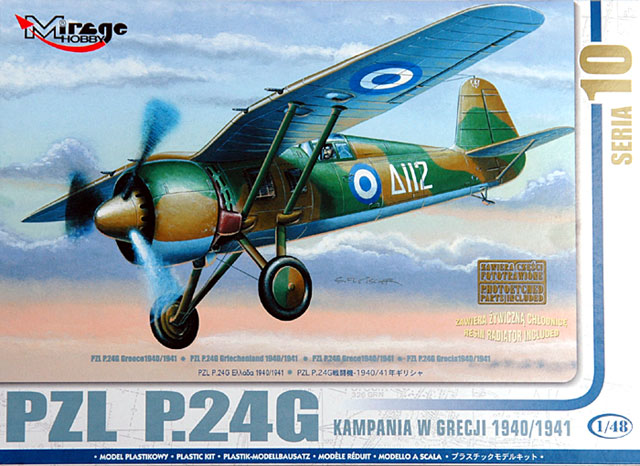
Mirage Hobby, 1/48
S
u m m a r y
|
| Catalogue Number: |
48108 |
| Scale: |
1/48 |
| Contents and Media: |
Injected styrene, resin, photo-etch
& acetate film |
| Price: |
USD$24.97
from Squadron.com |
| Review Type: |
First Look and Comparison to the
Mirage Hobby PZL P.11c |
| Advantages: |
Dimensionally accurate, well
detailed, excellent surface details, resin and photo-etched parts
included; 5 interesting versions used by many small air forces, no
serious fit problems evident, very nice markings options, high quality
decals |
| Disadvantages: |
Some flash |
| Recommendation: |
Highly Recommended |
Reviewed by
Mike Dobrzelecki

Mirage Hobby's
1/48 scale PZL P.24G is available online from Squadron.com
Even before the PZL P.11c fighter entered squadron service in 1933, the
Polish Air Force was already looking into its replacement. In the five to
six years that followed several more-modern fighter designs were proposed,
but only one was completed in prototype form, the low cantilever wing
retracting gear-equipped Seversky-like PZL P.50 Jazstrab ( Hawk), and none
entered into series production. Internal Polish politics and Poland's
limited military budget certainly played major roles in this sad story, but
the restrictions that Bristol put on sales of airframes, which were powered
by their license-built engines, also tied PZL's, (Panstowe Zaklady Lotnicze
- or National Aviation Works) hands. PZL, to their credit, got around the
restriction by designing an improved gull-winged fighter that would be
capable of handling a variety of radial engines, either already available,
or soon to be available. Export sales would not only keep the company
afloat, but bankroll the next generation of fighters for the Polish Air
Force; at least that was the plan. During the 1930's the Polish government
was somewhat succesful in upgrading their armor force using a similar, but
slightly modified scheme. They sold their ancient French Renault FT-17 tanks
to Spain for much more than they were worth and funded the purchase of the
excellent ( for its time) 7TP tank, which was based on the British Vickers 6
ton design. If you see an FT-17 in service during the Spanish Civil War (
either side ), it's a good chance that it was an Ex-Polish machine.
After PZL's chief designer, Zygmunt Pulawski was killed in an air crash
in 1933, Wsiewolod Jan Jakimiuk took over the task and shortly thereafter
came up with the P.24 improved design, which first flew in May 1933. The
P.24 was among the first fighters to mount 20mm cannons. Other improvements
included an enclosed glass-canopied cockpit ( the early prototypes still had
the P.11 style open cockpit ) and more powerful engines, such as the Gnome
Rhone 14N 14 cylinder radial engine. The second prototype, the P.24/II,
flown by Boselaw Orlinski, set a world speed record for radial-engined
fighters at 414 kph on June 28 1934. Greece, Bulgaria, Turkey and Romania
all purchased P.24's, which came in a choice of armament - two 20mm cannon
and two 7.9mm mg's or four 7.9mm mg's. Unlike the P.11c, all armament on the
production models was wing-mounted - only some of the prototypes had
fuselage guns, mounted on top of the fuselage with the butts protruding into
the cockpit under the windscreen, not in the sides, as on a P11.c. The P.24
still featured fixed gear, but that was not seen as much of a drawback to
foreign customers in the mid-1930's. The wings, tail group and much of the
fuselage was the same as on the P.11c.
As the 1930's unfolded Polish pilots watched with some envy as their
government exported improved P.24's to foreign customers, while they
soldiered on with their less capable P.11c's, which were getting worn-out,
as well as, obsolete by the end of that decade. P.24's were produced and
sold in the following variants:
-
P.24A - 14 sold to Turkey with another
batch produced under license. Turkish P.24's had Gnome Rhone 14kfs
radials and carried and armament of 2 x 7.92mm Browning mg's and 2 x
20mm Oerlikon FF cannon and 4 x 12.5kg bombs
-
P.24B - 12 sold to Bulgaria equipped with
the Gnome Rhone 14kfs radials and 4 x 7.92mm browning mg's and 4 x 12.5
kg bombs
-
P.24C - 26 sold to Turkey bombs were
limited to 2 x 12.5 kg.
-
P.24E - 6 sold to Romania with another
batch built under license with the Gnome Rhone 886hp or 926hp KIIIc36
radial and 4 x 7.92mm Browning mg's and 2 or 4 x 12.5 kg bombs and,
unlike the other P.24 variants, was equipped with a two-bladed prop,
rather than a three-bladed prop
-
P.24F - 7 sold to Greece equipped with a
938hp Gnome Rhone 14N-07 radial complete with spinner and 2 x 20mm
Oerlikon FF cannon and 2 x 7.92mm mg's and either 4 x 12.5 kg bombs or 2
x 50kg bombs
-
P.24G - 24 sold to Greece equipped with a
938hp Gnome Rhone 14N-07 radial complete with spinner and 2 x 20mm
Oerlikon cannon and 2 x 7.92mm mg's and either 4 x 12.5 kg bombs or 2 x
50kg bombs
As events grew more ominous in Europe and the P.50 ran into development
delays, desperate measures were taken by the Poles to fill the void with a
stop-gap program, from which was born the P.11g "Kobuz". Although designated
as part of the P.11 series, the "Kobuz" was really more a P.24 upgraded with
the very powerful twin-row Mercury VIII radial engine from the P.50. Reports
differ on its fit, but it most likely featured an enclosed cockpit, cowl
from the P.50, 4 x 7.92mm mg's ( some say all 4 mg's were in the wings,
others, two in the wings and two in the fuselage sides, as in a P.11c) and,
possibly, spatted wheels. There are reports that the Kobuz prototype was
flown in combat and obtained two kills over He-111's. There are also reports
from Luftwaffe pilots encountering P.24's in combat in September 1939, but
they were most likely misidentified P.11c's. Even the Luftwaffe could not
believe that the Poles would sell more modern fighters to other countries
leaving the lesser capable ones for their own air force - sad, but true.
See the Feature article on the
PZL P.24 by Lukasz Kedzierski here on Hyperscale for additional
information on Greek P.24's.
P.24 Kit Versions
The first two P.24s released are both Royal Hellenic Air Force examples:
-
Kit No. 48-107 - PZL P.24F with 2 x 20mm
Oerlikon FF cannon and 2 x 7.92mm mg's, with two Greek Air Force
markings choices : The first is "Black D106" ( The Letter 'D' is
rendered as a triangle for the Greek alphabet 'D', as in, 'D' for
'Delta'), from 22 Mira Dioxe ( Fighting Squadron), Great Mikra Airfield,
Thessalonika, September 1940, camouflaged in green and brown upper
surfaces and light blue lower surfaces and fitted with spats. The second
is "Black D129" from the same squadron, but with the spats removed.
-
Kit No. 48-108 - PZL P.24G with 4 x
7.92mm mg's, with four Greek Air Force markings choices; the first two,
both natural metal finish P.24's as first received from Poland in 1937
at Eleusis Airfield, Athens Greece with a choice of 'Black D115' or
'Black D116' numbers, fitted with spats. The third is a brown, green and
light blue camouflaged 'White D112' and the last, arguably the best
known Greek P.24, a brown, green and light blue camouflaged 'Black D102'
with the spiffy red spider on the portside fuselage below the
windscreen, reportedly flown by G.Laskaris. This aircraft was later
captured by the Germans at Argos Airfiled in April 1941. The camouflaged
versions properly show no spats fitted.
Three other versions are planned:
-
Kit No.48-104 - PZL P.24B Bulgarian Air
Force 'White 11' on the fuselage and 'White 2 on the fin, with a
striking sporty scheme of dark green upper surfaces with dark red cowl
and tapering band on the fuselage and dark red flashes on the spats and
light blue under surfaces.
-
Kit No.48-105 - PZL P.24A/C Turkish Air
Force in a natural metal scheme with spats and the white outlined red
squares of the Turkish Air Force and red rudder complete with a small
white crescent and and star.
-
Kit No. 48-106 - PZL P.24E Romanian (or
'Rumanian' as spelled on the box) 'White 6', camouflaged in green and
brown upper surfaces and light blue lower surfaces with yellow cowl,
fuselage band and wing tips. No spats are fitted.
Click the thumbnails below to
view larger images:
The question that may be raised by some modelers is, "Why did Mirage
release two Greek versions at once, rather than mix up the versions up a bit
?" One can only speculate that Mirage Hobby's marketing research indicated
that they would be the versions with the highest potential sales, given the
colorful combat career of the Royal Hellenic Air Forces P.24's.
Regarding Kit Nos. 48-105, 106 and 107, I can only indicate the color
schemes and markings on the box tops advertised and do not know what, if
any, alternate markings will be included with the other three kits. Knowing
Mirage Hobby, I'm sure they'll be some choices in the boxes. I eagerly await
the PZL P.24B, not only for its colorful Bulgarian markings, but also,
because with minor modifications, could be finished in a my favorite Polish
prototype scheme for the "B' model, sometimes refered to as the P.24/IV,
with its olive green upper surfaces and light blue lower surfaces and the
racy light blue tapering 'flash' along the fuselage and the spats, similar
to the Bulgarian paint scheme - just a different color combo. The Romanian
paint scheme is also very colorful and ranks as my second favorite.
Contents and Accuracy
By my rough count, including PE parts that have multiples, the P.24F kit
includes 63 injected plastic parts, 2 Clear parts, 4 resin ( 2 radiators and
2 manifolded exhuasts) and 36 Photo-etched parts - proving once again what a
bargain Mirage Hobby kits are in comparison to other manufacturers - all
this for US $24.97 retail. In the P.24G kit the styrene parts are mounted on
three sprues of gray styrene ( only 57 parts) and a fourth is included with
the P.24F kit covering the 20mm Oerlikon FF cannon pods and their
accompanying shorter wing support struts ( the struts go right through the
pod casings). The 20mm's were one of the selling points of the PZL export
sales brochures, but, in both protoype testing and service, the cannons
proved troublesome. During the test phase one prototype's cannon pod
exploded, which unfortunately was witnessed by some export customers. Not
skipping a beat, the PZL sales force pointed out how strong the Pulawski
wing was to withstand such an explosion without any damage from a "Swedish"
( read - non-Polish gun) ! Nice spin there, Pezetel. In service, most of the
P.24F's had their 20mm's removed and they were rearmed with 4 x 7.92mm mg's
- another note to be careful about when building the F model. "Black D129'
was one exception to this rule, retaining its 20mm's into 1941.
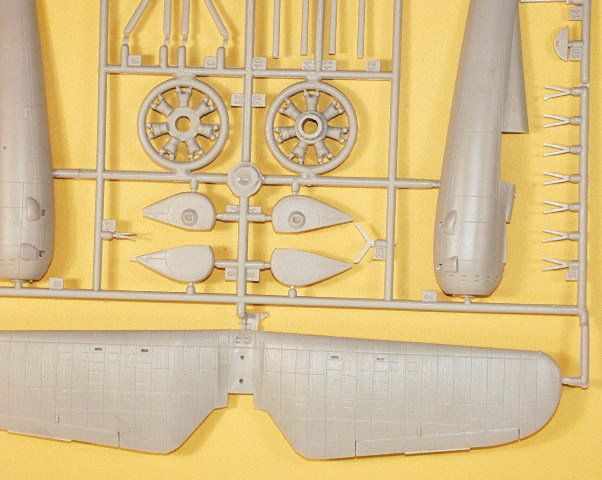
Click the thumbnails below to
view larger images:
The overall finish is the same as on the Mirage P.11c kit. The corrugated
wing, tail and fin surfaces are finely executed. The panel lines are almost
all engraved with some raised detail such as the step kickplates, which are
best sanded off and replaced with the photo-etched parts. The fuselage skin
is slightly grainy. The kit does have a bit of flash on some of the injected
parts. The P.24's share a problem with the P.11c kit, namely the cooling
vents in the fuselage and top of wing not being well defined. They should be
crisper and deeper. I made a comment in my in-box review of the P.11c that
the ribs on the under surfaces of the wing were a bit to pronounced for my
tastes at the time. I found that, after painting, they are less prominent
than feared - the same corrected comment applies to the P.24's.
In measuring the kit parts the wings spans out to a scale 35 feet, 1 1/2
inches. The dimensions in the old Profile publication lists it as 35 feet
3/4 inches. The drawings in Andrzej Glass's monograph on the P.24 measures
out to 35 feet 1 inch. The Marek Ryk drawings in the Ace publication on the
P.24 scale out to exactly 36 feet by my 'Murphy's Ruler'. Although it's not
really possible to comment on the kit's length against the drawings, since I
have not yet built the model, in matching the kit fuselage profile to the
drawings in the Glass reference, the diameter of the front fuselage around
the back row of cooling vents the kit appears to be smaller by about 1-2mm
in diameter.The leading edge of the back cockpit opening is short by about
1-2 mm. I mention these findings merely as an academic exercise to
illustrate a point that modelers often reference drawings noting minute
discrepancies with kits, but often they never consider the question as to
whether the drawings are accurate. Indeed, the drawings in the two sources I
referenced don't agree. In the final analysis, the Mirage kit's major
dimensions are more than close enough for me.
Engineering and Comparison to Mirage P.11c
Mirage continued the wise policy from their P.11c of molding the top wing
in one piece for the P.24. It also has the triangular nub on the bottom
front of the centerline of the top wing to facilitate mating it to the
fuselage. To have some fun I placed the main parts of the P.11c and P.24
kits side-by-side. I was curious to see what new revelations in the
evolution of the Pulawski design would come to light in the process.
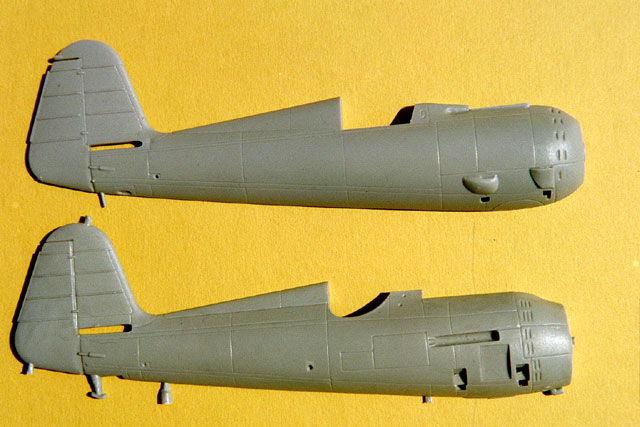
The wings are virtually the same, except for the center section and the
navigation lights on the P.24 kit, which, appropriately, are not on the
P.11c kit. Mirage cheated just a tiny bit ( and saved a ton of money) by
using the same sprue that comes in the P.11c kit that contains the lower
wings, tail planes, wheels, gear struts and miscellaneous interior and
exterior parts for both kits.That also explains the 4 shell ejection
fairings that were included in the P.11c kit. In turn, the top wing of the
P.24 has the nav lights on the leading edge of the wing tips, but modelers
will have to flesh them out on the bottom wings. The center section of the
P.24 top wing mold is modified to accept the new windscreen and enclosed
canopy. Separating the wing tips from the sprues may result in some repairs
in that area - caution is recommended here. The locations of the wing
struts, shell ejection fairings and bomb racks on the underside of thw wings
are clearly marked as smooth areas on the corrugated surface.
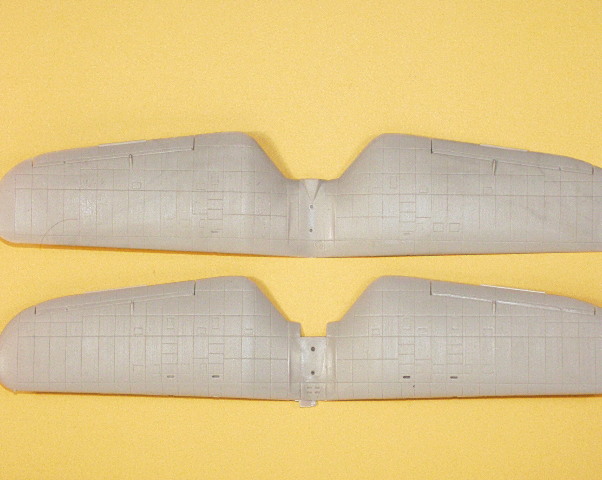
I continued the evolution comparison exercise in taping one fuselage half
from each kit together - portside P.11c and starboard side P.24. I reasoned
that, since the tail surfaces changed the least, using the presumed match in
that area for the hypothesis of the equation would be most logical. As
evident in the photos, even the panel lines start departing on the two kits
pretty quickly forward of the vertical fin.

Viewed from the bottom the P.24 fuselage is slightly longer and the
location of the jettisonable fuel tank is more forward than on a P.11c, as
are the strut and gear locating holes. The top match-up view reveals the
changes from the open cockpit P.11c to the enclosed cockpit P.24, the
different wing locations and disimilar cooling vent configurations. Although
the harsh shadows in the photo obscure the length difference, the side
profile match-up reveals the fuller depth of the spine fairing for the
enclosed canopy of the P.24 and, once again, the different shape of the
cockpit openings. The wing strut fairings on the fuselage are very different
on the P.24 than the P.11c. They were missing completely from the P.11c kit.
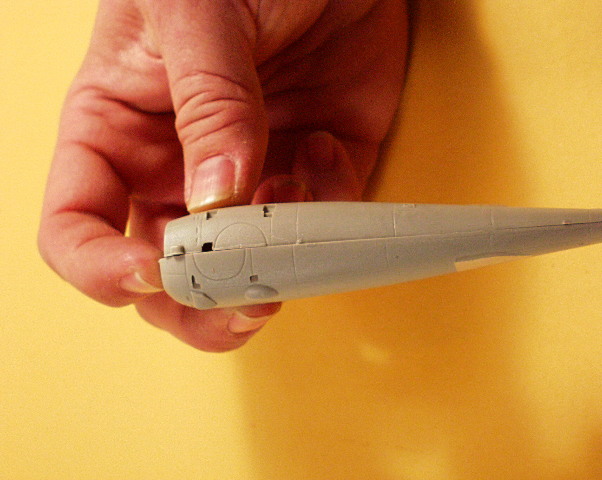
My 'Frankenstein modeling' exercise completed, I dry-fitted the two P.24
fuselage halves together and they appeared to be a good fit, unlike the
P.11c kit where I had to cut off locating pins. The jettisonable fuel tank
oval outline must be rescribed, as there is a noticeable gap on the 'Real
McCoy'. One or two mismatched panel lines on the bottom of the forward P.24
fuselage will have to be rescribed. In rereading my own review here on
Hyperscale for the Mirage Hobby P.11c kit, I realised that the instruction
sheet on the P.24 did not have the note on leaving the gap between the
horizontal tail plane and the fuselage. That's because the horizontal tail
plane was a flush tight fit on the P.24 with no gap whatsoever - just one
more subtle aerodynamic refinement in the evolution of the P.11 to P.24.
This was clear in photos of production P.24's and the kit faithfully
replicates this feature - so fill any minor gaps that occurs and watch out
that you do not obliterate the corrugations in the process of smoothing out
the joints. The cooling vents on the P.24 kit forward fuselage sing out in
perfect harmony with those on the P.11c kit for drilling out and deepening.
Dry-fitting the top wing/bottom wing assembly to the taped-together fuselage
halves reveals no particular problem, although it's not a lock-tight fit.
This is not such a drawback, as it allows wiggle-room for adjusting the
incidence and trueness in plan view. The join between the trailing edge of
the center of the wing top and the top of the fuselage trough it fits into
will require filling and sanding, especially on the top of the fuselage
ahead of the windscreen. Some minor filling of the bottom wing to the
fuselage sides may be required, but nothing out of the ordinary from normal
modeling. A deft hand with filler or Mr.Surfacer and you may not even need
sand paper. Happily, the fit of the windscreen and canopy to the fuselage is
as tight as a virgin - no spreader bar required here. The clear parts are
thin and just have a tiny bit of distortion on the bottom quarter panels of
the windscreen.
The cowling is molded to scale and very thin. Care should be taken in
assembling it by joining either the top or bottom first, letting it set,
then joining the other surface. The Gnome Rhone twin row 14 cylinder radial
is rather 'soft' in appearance and I will be looking for a resin
replacement, although, truth be told, not much will be visible after
installing the conical engine fairing. The cooling slots in the conical
fairing are not very defined and would benefit from opening them up. There
is flash on the prop and spinner halves that needs attention before they can
be joined together. The whole assembly should be sanded to blend it into a
smooth conical shape. The fact that the parts mentioned in this paragraph up
this point are on a separate sprue reveals Mirage's plan for molding the
other kits, which have different shapes for the P.24A,B,C and E models.
Mirage Hobby includes the cowl reinforcing struts, both fore and aft, but
they are very heavy and should be replaced with thinner wire stock in my
opinion.
I have not dry-fitted the wing struts on either kit and thus cannot comment
on their accuracy and length for either the P.24F with the 20mm pods or the
P.24G sans 20mm pods. The carburator intake, part number 6 has a knock-out
pin mark in the intake, which will have to reamed out anyway and could be
improved with installation of an inatke screen of some sort. The other
smaller parts are generally nice right of the box with some showing just a
bit of of flash. It will be up to the individual modeler how far he wants to
go to improve the kit parts.
Interior, Photoetched and Resin Parts
As with the P.11c kit, Mirage provides enough plastic, photoetch and
instrument panel film to produce a very nicely detailed cockpit right out of
the box. The same annoying nub on the dished section of the injected cockpit
floor is carried over from the P.11c. One noticebale difference on the P.24
kit is the absence of the sections of interior box structure that came with
the P.11c kit. In checking my references, it appears that yet another
refinement of the Pulawski design occurred in opening up the interior to
provide a more roomy cockpit for the pilot. A photo on page 48 of the
Andrzej Glass Monograph on the P.24 appears showing how the box structure of
the forward fuselage was truncated for this new design. The P.24 kit
fuselage has some shallow interior structure - formers and stringers -
molded onto it. Added in the P.24 kit is an photoetch trim wheel to be
mounted on an injected rod with bumpers on it, the whole of which is
installed below the seat.
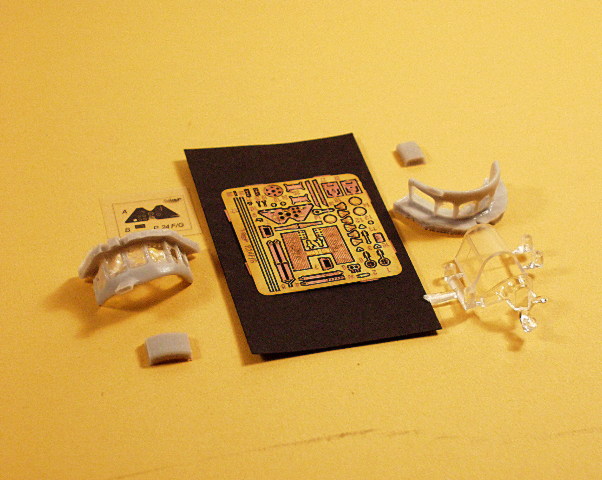
The photoetch provided in the kit is mostly for the interior, with the rest
of the items allowing for very detailed bomb racks for the wings, circular
fuselage inspection panels, the strap holding the jettisonable fuel tank,
airleron hinges, two different gun sights, and other miscellaneous parts.
The photoetch for the gear strut spring rods may have to be replaced, as
they did not last long while handling my P.11c model.
The photoetch instrumnet panel and acetate film instruments really look
great. I hope they fit easily into the interior. It's a safe bet that PART
will be releasing their own version of a photoetch sheet for the Mirage
Hobby P.24 family of kits. I definitely want a set of photoetch radiators
The manifolded exhaust pipes will require major clean up of the resin molds.
They are very delicate, so be careful when handling and working them. The
opening of the exhaust ports are nicely rendered. The other resin parts
cover the radiators, which are better replaced with photoetch radiators when
they become available. Noticeably absent are any resin bombs in either kit.
That's a pity, since the Mirage Hobby 12.5 kg bombs in the kit number 48-102
issue of the P.11c kit are exquisite. Some models of the P.24 were capable
of carrying heavier 50kg bombs and I would have liked to see them included.
I wonder what the bombs looked like that the Greeks used, if any.
Instructions
As with their P.11c kits, Mirage Hobby once again has provided an
instruction sheet that is a cut above most companies in terms of research,
historical information and specific instructions as to the armament and fit
of each aircraft depicted on the decal sheet. The language choices
appropriately enough include Greek in addition to the expected Polish and
English text. I hate to repeat myself, but modelers are well advised to
study the instruction sheet thoroughly before embarking on cutting parts off
the trees and plunging ahead with either a dry fit, or build.
For both kits, notes appear warning the modeler to gently remove the raised
plastic in the area where the photo-etch bomb racks are mounted. They also
suggest leaving off the pitot tube until after decal application. Missing is
a similar warning on the photo-etch bomb racks - a bitter lesson Ilearned on
the P.11c kit, but which would only apply, if there are decals in the area
of the racks. The manifolded exhausts are to be installed somewhat
assymetrically from left to right side lining up with the appropriate Gnome
Rhone cylinders, I suppose. There's a note on the P.24F instructions
refering you to the "Suggested Reading" bibliography to acquaint the modeler
on the details of the assymetrical configuration of the exhausts - something
I'll have to study, myself. This list is missing from the P.24G instructions
for some reason. The bibliography is listed at the end of this review with a
couple of additions of my own.
Another cautionary note covers application of decals over corrugated
surfaces. That goes double for the ribs on the wings' undersurfaces.
On the P.24F kit, mention is made that, although the spats are shown in the
side profile on 'Black D106', they were removed during service. Curiously,
on the P.24G kit details of the camouflage and markings are only provided
for two out of the four schemes on the instruction sheet the modeler being
left to deduce that 'Black D115' can be finished in natural metal like
'Black D116'. Luckily, the box art for 'Black D102' on the backside of the
kit box provides information needed for that scheme. The instruction sheet
also mentions that "White D112" probably carried a three tone scheme.
Although the instruction sheet shows only two upper surface colors, I take
the note to mean that some sources indicate 3 upper surface colors, as shown
in the English Profile No.170 on the P.24 by J.Cynk.
Paint colors are called out in Polish and English and references are made to
both Humbrol and Vallejo paints, the latter inclusion showing the inroads
this acrylic paint company has made in the hobby during the past few years.
For natural metal P.24's the front face of the prop blades are natural metal
also, with the backsides painted in black to reduce glare. For camouflaged
birds paint both sides black with the tips picked out in the usual yellow.
Credit is given where due to A.Glass, Verras Stauros, Papadimitriou George
and Costas Kalfakis, the latter 3 from IPMS Greece (that's IPMS, not IMPS !)
and the former, the all-around noted Polish aviation historian.
Decals
The Mirage Hobby P.24 kit decals are prodcued by Techmod and are
well-printed, in register and the colors are very vibrant. The Techmod
decals in the P.11c kit I built were thin, yet opaque. Of course, they were
installed on the monotone surfaces of the P.11c and I can not comment how
opaque they will appear on a two-tone upper surface camouflage scheme of the
P.24. I had to float the P.11c decals on with alot of Microset, since they
tended to stay where first located. They responded nicely to Micro Sol
setting solution and snuggled down perfectly. I expect that the P.24 decals
will act the same. The markings choices were covered earlier in this review,
but mention should be made about the Greek roundels, which the instruction
sheet for the P.24G kit indicates that, on camouflaged machines in the
beginning, the large diameter roundels were present on the upper and lower
wings, close to the tips and outside of the wing strut locations. During
later service, especially in wartime, the roundels were overpainted in green
or dark earth on the upper surfaces and light blue on the lower surfaces. In
some cases the lower wing roundels were overpainted with broad blue bands
which also served as a ready identification guide for Greek anti-aircraft
units - the kit example being 'White D112'.
Click the thumbnails below to
view larger images:
Small bonuses on both decal sheets include logos for the prop blades. The
P.24G kit sheet also has a weight data stencil, the PZL factory symbol and
P.24 type designator for the fin. These are not present on the P.24F sheet.
Once again - a reminder is necesary to install any decals in the location of
the bomb racks first BEFORE installation of the photoetch bomb racks,
themselves. I suppose that there is still room for after-market decal
sheets, although it appears that Mirage Hobby pretty much has most of the
field covered with the five kit issues they have planned.
Mirage Hobby's series of P.24 kits will provide quarter scale modelers
with many hours of enjoyment, especially considering the colorful markings
choices. I would venture a guess to say that Royal Hellenic Air Force fans,
especially in Greece, are chomping at the bit to get this kit and build it.
It is vastly superior to the cottage industry Warrior kit of the P.24 which
was based on the LTD P.11c. I could also see conversion possibilities of
kit-bashing an early open cockpit P.24 prototype using parts from the
Broplan P.11a.
Critics and hobby pundits needing affirmation in their lives will point out
that Mirage's P.24's, like their P.11c brethren, are not Tamigawa shake 'n
bake kits. My rebuttal to that is; In a sea of Tamiya P-51's and P-47's on a
contest table, contestants and convention visitors alike will be drawn to a
well-built Mirage Hobby P.24 kit. It only requires the usual modeling skills
to turn it into a masterpiece. My P.11c has managed to beat out competition
in the form of Tamigawa models at several IPMS shows and that's just
out-of-the box and I humbly submit that I am far from being the best modeler
around, so it must be the basis from which I started - the Mirage kit,
itself, that deserves a good share of the honors. Other modeler's builds of
the Mirage Hobby P.11c have appeared on the internet far surpassing the job
I did on my 121 Eskadra bird, so I am not alone in that opinion. I'm sure
that built-up P.24's will begin popping up on the internet shortly.
Last year I visited my ancestral homeland for the first time to take part
in the 85th Anniversary celebration of the Polish Air Force. I was honored
with an invitation from the Polish Air Force Veterans Association in America
to these festivities in gratitude for the various museum exhibits I have
supervised over the 15 years in homage to Polish vets for institutions, such
as the Intrepid Sea-Air-Space Museum in Manhattan and the Museum of Polish
Military Heritage, also located in the Big Apple. For me it was a trip of a
lifetime - VIP tours to museums, seeing the Polish Air Force vets from WWII
that I have not seen since the last worldwide PAFVA reunion I attended in
1994 when it was held in New Jersey, meeting Polish aviation historians for
the first time, including Jerzy Cynk, that I have corresponded with for
years, concerts and banquets complete with great food and lots and lots of
alcoholic beverages.
During the week long celebration, I managed squeeze in a tour to Mirage
Hobby's offices in Warsaw. Wojciech Bulhak graciously showed me around the
facility and gave me a peek at the box art for the P.24 kits, as well as the
CAD drawings for the PZL P.23 Karas kit parts due out in several months from
now. The Karas kits are going to be really something from what I have seen
on the PC screen.
After the reunion was over, I took a train down to Krakow, from which my
grandfather on my mother's side emigrated. In addition to the 14th century
delights of Krakow's architecture, I made my Mecca to the Muzeum Lotnictwa
Polskiego (Polish Aviation Museum, which is only 10-15 minutes outside of
the city center. The museum is located on the former pre-war Krakow-Rakowice
airbase of the 2nd Air Regiment, home to 121 Eskadra - the Winged Arrows -
Wladek Gnys's old base. I spent a few hours in the morning going over a
selection of aviation photos and original documents I have collected over
the years with the museum staff and presented them with a copy of those
items for their archives. They, in turn, let me have access to the aircraft
not normally granted to aviation historians, let alone the casual museum
visitor. Attached to this review are a couple of bonus shots, including a
very happy Mike D sitting in the cockpit of the sole remaining PZL P.11c.
-
PZL P.24 Monograph, by Andrzej Glass,
Wydawnictwo Militaria, 1994 ( same format as a Squadron Publications In
Action book )
-
PZL P.24, Series 'Pod Lupa' No.15, Ace
Publications 2002
-
Profile Publications No. 170, The PZL
P.24 , by Jerzy Cynk, 1967
-
Samoloty Wojskowe W Polsce 1924-1939, by
Andrzej Morgala, Bellona 2003
-
Dragon Hobby 4/199 - "PZL P.24 w Turcji",
by Andrzej Glass, Mirage Hobby 1999
-
Hellenic Wings Vol.1 1908-1944
-
Bullletin IPMS Elliados 1/1999
There is also a new Kagero Publication just recently released
Review and Images Copyright © 2004 by
Mike Dobrzelecki
Page Created 21 April, 2004
Last updated 12 August, 2004
Back to HyperScale Main Page
Back to Reviews Page
|
Home | What's
New | Features
| Gallery |
Reviews | Reference
| Forum
| Search